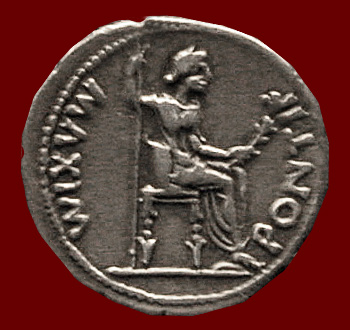 denarius of Tiberius, 14-37 CE: reverse
denarius of Tiberius, 14-37 CE: reverse denarius of Tiberius, 14-37 CE: reverse
denarius of Tiberius, 14-37 CE: reverseAugustus never depicted Livia on any of his official Roman coins, though her portrait and/or inscription appeared on some local coin issues in the eastern provinces during his reign. The situation was more complex during the reign of Tiberius, however, since the dowager empress was a revered figure, the Julia Augusta, adopted into Augustus' family line and serving as priestess of the cult of the deified Augustus. Her association with and support of Tiberius helped to validate his position. Tiberius did not issue official Roman coins with Livia's portrait and name, but he did allude to her in various ways on his official coinage. For example, there are numerous examples of precious metal coins from the mint of Rome with a seated female figure on the reverse allegorically representing Peace (Pax). This figure can be seen on the silver denarius above and the gold aureus below.
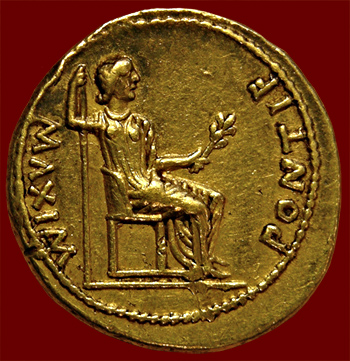 aureus of Tiberius, 14-37 CE: reverse
aureus of Tiberius, 14-37 CE: reverseShe holds either a scepter or an inverted spear and an olive branch. She wears a diadem and has her hair drawn back into a bun in a fashion similar to the hairstyle worn by Livia. Although the inscription refers to Tiberius' position as Pontifex Maximus and there are no overt references to Livia, many scholars feel that users of the coins would have associated the figure with Livia and that this association was probably intended by Tiberius. Certainly coins issued locally in the provinces made this association, since the seated figure is often explicitly identified as Livia, as in the coin from Cyprus below, whose inscription names Julia Augusta.
 bronze of Tiberius from Cyprus, 14-37 CE: reverse
bronze of Tiberius from Cyprus, 14-37 CE: reverseOn another provincial bronze of Tiberius from the mint of Utica, the association of the seated female, who holds a scepter and libation bowl (patera) with Livia is strengthened by the inscription on the obverse of the coin, which identified Tiberius as the son of Divus Augustus.
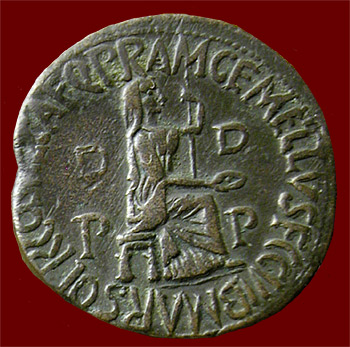 bronze of Tiberius from Utica, 14-21 CE: reverse
bronze of Tiberius from Utica, 14-21 CE: reverseThe following dupondius of Tiberius from the official mint of Rome has a more direct connection with Livia and bears a portrait that clearly resembles statues of the empress. This portrait appears on the obverse (the face) of the coin rather than the reverse, which includes a large SC and an inscription referring to the 24th tribunician year of Tiberius, 22-23 CE. Although in the inscription beneath the portrait Augusta is an adjective modifying the allegorical Salus (“health, safety”), this must certainly have suggested Livia to anyone handling the coin, not only because of her title Augusta, but also because she had just recovered from a serious illness in 22 CE. The phrase Salus Augusta may refer to the well-being of Livia, the Augustan family, the state, or all of these simultaneously.
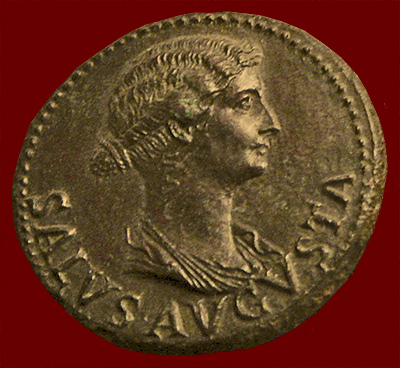 dupondius of Tiberius, 22-23 CE: obverse
dupondius of Tiberius, 22-23 CE: obverseOn the following sestertius of Tiberius, whose reverse is almost identical with the previous coin, the obverse refers specifically to Livia with the inscription SPQR IVLIAE AVGVST[ae]. Instead of a portrait, the coin depicts a beautifully decorated carpentum, or covered cart, drawn by two mules. Riding in such a carriage on public festivals in Rome was a very special privilege reserved for the Vestal Virgins and granted by the Senate as a special honor to a few women. This coin may refer to the fact that in 22 CE the Senate granted Livia the right to sit with the Vestals at public games, and she may also have been granted the right to ride in a carpentum at this time.
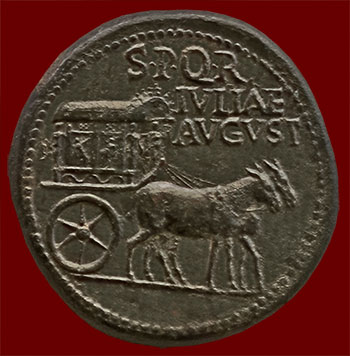 sestertius of Tiberius, 22-23 CE: obverse
sestertius of Tiberius, 22-23 CE: obverseThe last coin shown here was issued long after Livia's death by her grandson Claudius, who had officially deified Livia in January of 42 CE; hence the inscription DIVA AVGVSTA. The obverse of these coins showed Divus Augustus wearing the radiate crown that indicated divinity; the reverse borrowed from the previous coins the image a seated Livia, but here she is definitely associated with the goddess Ceres, since she holds a long torch in her left hand and poppies and wheat in her right.
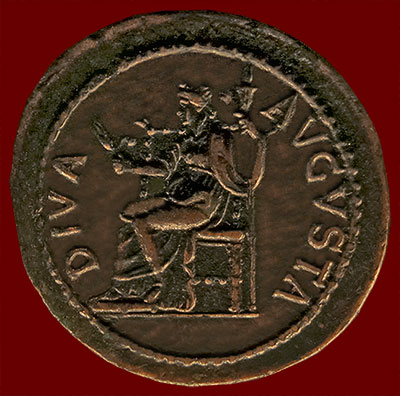 dupondius of Claudius, 42-50 CE: reverse
dupondius of Claudius, 42-50 CE: reverseClose this window when finished
Barbara F. McManus